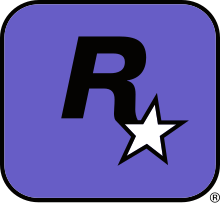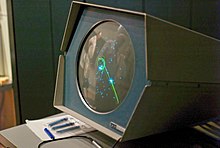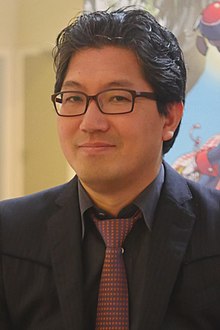Portal:Video games
Portal maintenance status: (April 2019)
|
The Video Games Portal

A video game, also known as a computer game or just a game, is an electronic game that involves interaction with a user interface or input device (such as a joystick, controller, keyboard, or motion sensing device) to generate visual feedback from a display device, most commonly shown in a video format on a television set, computer monitor, flat-panel display or touchscreen on handheld devices, or a virtual reality headset. Most modern video games are audiovisual, with audio complement delivered through speakers or headphones, and sometimes also with other types of sensory feedback (e.g., haptic technology that provides tactile sensations). Some video games also allow microphone and webcam inputs for in-game chatting and livestreaming.
Video games are typically categorized according to their hardware platform, which traditionally includes arcade video games, console games, and computer (PC) games; the latter also encompasses LAN games, online games, and browser games. More recently, the video game industry has expanded onto mobile gaming through mobile devices (such as smartphones and tablet computers), virtual and augmented reality systems, and remote cloud gaming. Video games are also classified into a wide range of genres based on their style of gameplay and target audience. (Full article...)
Featured articles – load new batch
-
Image 1Thatgamecompany, Inc. (stylized as thatgamecompany) is an American independent video game development company founded by University of Southern California students Jenova Chen and Kellee Santiago in 2006. The company was a developer for Sony Computer Entertainment, contracted to create three downloadable games for the PlayStation 3's PlayStation Network service, and has since secured independent funding. The first of their games is a remake of Chen's award-winning Flash title Flow, with enhanced visuals and sound, added multiplayer modes and compatibility with the PlayStation 3's motion-sensitive controller. The title was released on the PlayStation Store in 2007. The company's second PlayStation 3 game, Flower, was released on the PlayStation Store in 2009, and their third game, Journey, was released in March 2012 on the PlayStation Store. Their fourth game, Sky: Children of the Light, was released in July 2019 on iOS and in April 2020 on Android. Later, it released on the Nintendo Switch in June 2021 and on PlayStation 4 in December 2022.
According to Chen, the company focuses on creating video games that provoke emotional responses from players. He has stated that, while the company is not opposed to making action-oriented games, he believes that enough such titles are released by the established video game industry. When designing a game, Chen and Thatgamecompany's process is to start by mapping out what the game should make the player feel, rather than by establishing game mechanics. Chen has stated that the company does not plan to produce large, blockbuster titles, due to their belief that the pressure for high sales would stifle innovation. (Full article...) -
Image 2The Sega Genesis, known as the Mega Drive outside North America, is a 16-bit fourth generation home video game console developed and sold by Sega. It was Sega's third console and the successor to the Master System. Sega released it in 1988 in Japan as the Mega Drive, and in 1989 in North America as the Genesis. In 1990, it was distributed as the Mega Drive by Virgin Mastertronic in Europe, Ozisoft in Australasia, and Tectoy in Brazil. In South Korea, it was distributed by Samsung Electronics as the Super Gam*Boy and later the Super Aladdin Boy.
Designed by an R&D team supervised by Hideki Sato and Masami Ishikawa, the Genesis was adapted from Sega's System 16 arcade board, centered on a Motorola 68000 processor as the CPU, a Zilog Z80 as a sound controller, and a video system supporting hardware sprites, tiles, and scrolling. It plays a library of more than 900 games on ROM-based cartridges. Several add-ons were released, including a Power Base Converter to play Master System games. It was released in several different versions, some created by third parties. Sega created two network services to support the Genesis: Sega Meganet and Sega Channel.
In Japan, the Mega Drive fared poorly against its two main competitors, Nintendo's Super Famicom and NEC's PC Engine, but it achieved considerable success in North America, Brazil, and Europe. Contributing to its success was its library of arcade game ports, the popularity of Sega's Sonic the Hedgehog series, several popular sports franchises, and aggressive youth marketing that positioned it as the cool console for adolescents. The 1991 North American release of the Super Nintendo Entertainment System triggered a fierce battle for market share in the United States and Europe known as the "console war". This drew attention to the video game industry, and the Genesis and several of its games attracted legal scrutiny on matters involving reverse engineering and video game violence. Controversy surrounding violent games such as Night Trap and Mortal Kombat led Sega to create the Videogame Rating Council, a predecessor to the Entertainment Software Rating Board. (Full article...) -
Image 3

Sega Enterprises Ltd. v. Accolade, Inc., 977 F.2d 1510 (9th Cir. 1992), is a case in which the United States Court of Appeals for the Ninth Circuit applied American intellectual property law to the reverse engineering of computer software. Stemming from the publishing of several Sega Genesis games by video game publisher Accolade, which had disassembled Genesis software in order to publish games without being licensed by Sega, the case involved several overlapping issues, including the scope of copyright, permissible uses for trademarks, and the scope of the fair use doctrine for computer code.
The case was filed in the U.S. District Court for the Northern District of California, which ruled in favor of Sega and issued an injunction against Accolade preventing them from publishing any more games for the Genesis and requiring them to recall all the existing Genesis games they had for sale. Accolade appealed the decision to the Ninth Circuit on the grounds that their reverse engineering of the Genesis was protected under fair use. The Ninth Circuit reversed the district court's order and ruled that Accolade's use of reverse engineering to publish Genesis titles was protected under fair use, and that its alleged violation of Sega trademarks was the fault of Sega. The case is frequently cited in matters involving reverse engineering and fair use under copyright law. (Full article...) -
Image 4Outer Wilds is a 2019 adventure video game developed by Mobius Digital and published by Annapurna Interactive. The game follows the player character as they explore a planetary system stuck in a 22-minute time loop that resets after the sun goes supernova and destroys the system. Through repeated attempts they investigate the alien ruins of the Nomai to discover their history and the cause of the time loop.
The game began development in 2012 as director Alex Beachum's master's thesis. He was inspired to create a game focused on exploration in which the player character was not the center of the game world. Beachum led a small team in building the game, first as an independent project, then as a commercial game at Mobius after the project won the Excellence in Design and Seumas McNally Grand Prize awards at the 2015 Independent Games Festival. Annapurna joined the project as the publisher in 2015 and funded its expansion beyond a student project.
Outer Wilds was released for Windows, Xbox One, and PlayStation 4 in 2019, for PlayStation 5 and Xbox Series X/S in 2022, and for Nintendo Switch in 2023. An expansion which explores further themes in a new location in the planetary system, Echoes of the Eye, was begun in 2019 and released for the same platforms in 2021. Outer Wilds was positively received upon release, with most critics acclaiming its design and some criticizing the uneven difficulty of gameplay and pursuing the game's mysteries. Echoes of the Eye was also positively received, with some criticism for its introduction of horror elements. Outer Wilds was featured in several game of the year lists for 2019 as well as game of the decade lists, and won in multiple categories at award shows, including the Best Game award at the 16th British Academy Games Awards. (Full article...) -
Image 5Vagrant Story (ベイグラントストーリー, Beiguranto Sutōrī) is an action role-playing game developed and published by Square for the PlayStation video game console. The game was released in 2000 and has been re-released by Square Enix through the PlayStation Network for the PlayStation 3, PlayStation Portable and PlayStation Vita consoles. Vagrant Story was primarily developed by the team responsible for Final Fantasy Tactics, with Yasumi Matsuno serving as producer, writer and director.
The game takes place in the kingdom of Valendia and the ruined city of Leá Monde. The story centers on Ashley Riot, an elite agent known as a Riskbreaker, who must travel to Leá Monde to investigate the link between a cult leader and a senior Valendian Parliament member, Duke Bardorba. In the prologue, Ashley is blamed for murdering the duke, and the game discloses the events that happen one week before the murder.
Vagrant Story is unique as a console action-adventure role-playing game in that it features no shops and no player interaction with other characters; instead, the game focuses on weapon creation and modification, as well as elements of puzzle-solving and strategy. The game received critical acclaim from gaming magazines and websites, with some calling it one of the greatest games ever made. (Full article...) -
Image 6Sonic X-treme was a platform game developed by Sega Technical Institute from 1994 until its cancellation in 1996. It was planned as the first fully 3D Sonic the Hedgehog game, taking Sonic into the 3D era of video games, and the first original Sonic game for the Sega Saturn. The storyline followed Sonic on his journey to stop Dr. Robotnik from stealing six magic rings from Tiara Boobowski and her father. X-treme featured open levels rotating around a fixed center of gravity and, like previous Sonic games, featured collectible rings and fast-paced gameplay.
X-treme was conceived as a side-scrolling platform game for the Sega Genesis to succeed Sonic & Knuckles (1994). Development shifted to the 32X and then the Saturn and Windows, and the game was redesigned as a 3D platform game for the 1996 holiday season. The plan was disrupted by company politics, an unfavorable visit by Japanese Sega executives, and obstacles with the game engines planned for use, including one from Sonic Team for Nights into Dreams (1996). Amid increasing pressure and declining morale, designer Chris Senn and programmer Chris Coffin became ill, prompting producer Mike Wallis to cancel the game. A film tie-in with Metro-Goldwyn-Mayer was also canceled.
In place of X-treme, Sega released a port of the Genesis game Sonic 3D Blast, but did not release an original 3D Sonic platform game until Sonic Adventure for the Dreamcast in 1998. The cancellation is considered an important factor in the Saturn's commercial failure, as it left the system with no original Sonic platform game. Elements similar to those in X-treme appeared in later games, such as Sonic Lost World (2013). (Full article...) -
Image 7
Spacewar! is a space combat video game developed in 1962 by Steve Russell in collaboration with Martin Graetz, Wayne Wiitanen, Bob Saunders, Steve Piner, and others. It was written for the newly installed DEC PDP-1 minicomputer at the Massachusetts Institute of Technology. After its initial creation, Spacewar! was expanded further by other students and employees of universities in the area, including Dan Edwards and Peter Samson. It was also spread to many of the few dozen installations of the PDP-1 computer, making Spacewar! the first known video game to be played at multiple computer installations.
The game features two spaceships, "the needle" and "the wedge", engaged in a dogfight while maneuvering in the gravity well of a star. Both ships are controlled by human players. Each ship has limited weaponry and fuel for maneuvering, and the ships remain in motion even when the player is not accelerating. Flying near the star to provide a gravity assist was a common tactic. Ships are destroyed when they collide with a torpedo, the star, or each other. At any time, the player can engage a hyperspace feature to move to a new and random location on the screen, though in some versions each use has an increasing chance of destroying the ship instead. The game was initially controlled with switches on the PDP-1, though Bob Saunders built an early gamepad to reduce the difficulty and awkwardness of controlling the game.
Spacewar! is one of the most important and influential games in the early history of video games. It was extremely popular in the small programming community in the 1960s and the public domain code was widely ported to and recreated on other computer systems at the time, especially after computer systems with monitors became more widespread towards the end of the decade. It has also been recreated in more modern programming languages for PDP-1 emulators. It directly inspired many other video games, such as the first commercial arcade video games, Galaxy Game and Computer Space (both from 1971), and later games such as Asteroids (1979). In 2007, Spacewar! was named to a list of the ten most important video games in history, which formed the start of the game canon at the Library of Congress, and in 2018 it was inducted into the World Video Game Hall of Fame by The Strong and the International Center for the History of Electronic Games. (Full article...) -
Image 8
Colossal Cave Adventure (also known as Adventure or ADVENT) is a text-based adventure game, released in 1976 by developer Will Crowther for the PDP-10 mainframe computer. It was expanded upon in 1977 by Don Woods. In the game, the player explores a cave system rumored to be filled with treasure and gold. The game is composed of dozens of locations, and the player moves between these locations and interacts with objects in them by typing one- or two-word commands which are interpreted by the game's natural language input system. The program acts as a narrator, describing the player's location and the results of the player's attempted actions. It is the first well-known example of interactive fiction, as well as the first well-known adventure game, for which it was also the namesake.
The original game, written in 1975 and 1976, was based on Crowther's maps and experiences caving in Mammoth Cave in Kentucky, the longest cave system in the world; further, it was intended, in part, to be accessible to non-technical players, such as his two daughters. Woods's version expanded the game in size and increased the number of fantasy elements present in it, such as a dragon and magic spells. Both versions, typically played over teleprinters connected to mainframe computers, were spread around the nascent ARPANET, the precursor to the Internet, which Crowther was involved in developing.
Colossal Cave Adventure was one of the first teletype games and was massively popular in the computer community of the late 1970s, with numerous ports and modified versions being created based on Woods's source code. It directly inspired the creation of numerous games, including Zork (1977), Adventureland (1978), Mystery House (1980), Rogue (1980), and Adventure (1980), which went on to be the foundations of the interactive fiction, adventure, roguelike, and action-adventure genres. It also influenced the creation of the MUD and computer role-playing game genres. It has been noted as one of the most influential video games, and in 2019 was inducted into the World Video Game Hall of Fame by The Strong and the International Center for the History of Electronic Games. (Full article...) -
Image 9

Rockstar San Diego, Inc. (formerly Angel Studios, Inc.) is an American video game developer and a studio of Rockstar Games based in Carlsbad, California. The studio is best known for developing the Midnight Club and Red Dead series.
The Colombian entrepreneur Diego Angel founded the company as Angel Studios in January 1984 after studying film in Chicago, where he had grown fond of computer animation. The studio began with a focus on animation and visual effects for multimedia productions, such as advertisements, films, and music videos. Notable works include the film The Lawnmower Man and the music video for Peter Gabriel's song "Kiss That Frog". Angel Studios began working in the video game industry during the 1990s, creating cutscenes for Ed Annunziata's Ecco: The Tides of Time (1994) and Mr. Bones (1996). The company fully developed games with Nintendo (Major League Baseball Featuring Ken Griffey Jr. and Ken Griffey Jr.'s Slugfest) and Microsoft (Midtown Madness and Midtown Madness 2), and it produced a port of Capcom's Resident Evil 2 for the Nintendo 64.
Rockstar Games was impressed with the studio's work on Midtown Madness and offered a long-term partnership in 1999, which resulted in the creation of the Midnight Club and Smuggler's Run series. The publisher's parent company, Take-Two Interactive, acquired Angel Studios in November 2002 and integrated it with Rockstar Games as Rockstar San Diego. Angel left the studio in May 2005 and returned to Colombia. Since 2004, Rockstar San Diego has operated an internal game engine team that develops Rockstar Games's proprietary Rockstar Advanced Game Engine, which is used in most of the publisher's titles. The studio led the development of further Midnight Club games, Red Dead Revolver (2004), Red Dead Redemption (2010), and its expansion pack Undead Nightmare. It collaborated with other Rockstar Games studios on Max Payne 3 (2012), Grand Theft Auto V (2013), and Red Dead Redemption 2 (2018). (Full article...) -
Image 10Doom is a 2016 first-person shooter video game developed by id Software and published by Bethesda Softworks. The game is the first major installment in the Doom series since 2004's Doom 3 and was a reboot of the franchise. It was released for PlayStation 4, Windows, and Xbox One in May 2016. A port for Nintendo Switch was co-developed with Panic Button and released in November 2017, and a version for Google Stadia was released in August 2020. Players take the role of an unnamed space marine, known as the "Doom Slayer", as he battles demonic forces within an energy-mining facility on Mars and in Hell.
Doom was announced as Doom 4 in 2008, and that version underwent an extensive development cycle with different builds and designs before the game was restarted in 2011 and re-revealed as simply Doom in 2014. It was tested by customers who pre-ordered the 2014 MachineGames game Wolfenstein: The New Order and the general public. Mick Gordon composed the music, with contributions by Richard Devine. The game also has an online multiplayer component and a level editor known as "SnapMap", co-developed with Certain Affinity and Escalation Studios respectively.
Doom was well received by critics and players. The single-player campaign, graphics, soundtrack, and gameplay received considerable praise, whereas the multiplayer mode drew significant criticism. It was the second best-selling video game in North America and the United Kingdom in the week of its release and sold over 500,000 copies for PCs by the end of May 2016. A sequel, Doom Eternal, was released in March 2020. A prequel, Doom: The Dark Ages, is set to be released in 2025. (Full article...)
Did you know... - show different entries
- ... that when Kaz Ayabe pitched his video game Boku no Natsuyasumi to Sony, he said that illustrator Mineko Ueda was interested in the project even though they had never actually met?
- ... that the video game mode Ultimate Team has been criticized for its reliance on loot box packs, considered to be a controversial form of gambling?
- ... that the success of Kingdom Rush prompted plans to grow the video game industry of Uruguay?
- ... that the web-based video game Moderator Mayhem was based on a card game meant to demonstrate the difficulties of content moderation?
- ... that a version of the video game Rhino Rumble was not released due to the creators not wanting to add licensed characters?
- ... that a pink skin for Mercy in the video game Overwatch helped raise more than $12 million for breast cancer research?
- ... that the 2014 text adventure The Uncle Who Works for Nintendo is inspired by a source cited by children for spreading video game rumors?
- ... that the 1999 video game Interplay Sports Baseball Edition 2000 used a public-address announcer while its rivals were switching to two commentators as featured on real MLB game broadcasts?
- ... that after becoming paralyzed from the neck down, Rocky "RockyNoHands" Stoutenburgh broke two Guinness World Records in the video game Fortnite?
- ... that the video game Fursan al-Aqsa received an update that allows players to reenact the October 7 attacks on Israel?
- ... that the 1979 video game Superman was one of the first console games with a pause feature?
- ... that the science-fiction video game The Anacrusis is named after a musical term?
Selected biography – load new batch
-
Image 1Satoru Iwata (Japanese: 岩田 聡, Hepburn: Iwata Satoru, December 6, 1959 – July 11, 2015) was a Japanese businessman, video game programmer, video game designer, and producer. He was the fourth president and chief executive officer (CEO) of Nintendo from 2002 until his death in 2015. He was a major contributor in broadening the appeal of video games by focusing on novel and entertaining games rather than top-of-the-line hardware.Iwata at Game Developers Conference in 2011
Born in Sapporo, Iwata expressed interest in video games from an early age and created his first simple game while in high school. He majored in computer science at the Tokyo Institute of Technology. In 1980, he joined the game developer HAL Laboratory while attending the university. At HAL, he worked as a programmer and closely collaborated with Nintendo, producing his first commercial game in 1983. Games to which he contributed include EarthBound and many games in the Kirby series. Following a downturn and near-bankruptcy, Iwata became the president of HAL in 1993 at the insistence of Nintendo president Hiroshi Yamauchi and brought financial stability. In the following years, he worked in the development of the Pokémon and Super Smash Bros. series. Iwata joined Nintendo as the head of its corporate planning division in 2000. (Full article...) -
Image 2Shinji Mikami (三上 真司, Mikami Shinji, born August 11, 1965) is a Japanese video game designer, director, and producer. Starting his career at Capcom in 1990, he has worked on many of the company's most successful games. He directed the first installment of the Resident Evil series in 1996 and the first installment of the Dino Crisis series in 1999, both survival horror games. He returned to Resident Evil to direct the remake of the first game in 2002 and the survival horror third-person shooter Resident Evil 4 in 2005. In 2006, he directed his final Capcom game God Hand, a beat 'em up action game. Mikami founded PlatinumGames in 2006 and directed the third-person shooter Vanquish in 2010. That same year he left the studio and founded a new studio Tango Gameworks and directed the survival horror game The Evil Within in 2014. He has also served the roles of producer and executive producer for many games. In 2023, he left the studio and founded a new studio KAMUY in 2024.
In 2009, he was chosen by IGN as one of the top 100 game creators of all time. (Full article...) -
Image 3
Jordan Mechner (born June 4, 1964) is an American video game designer, graphic novelist, author, screenwriter, filmmaker, and former video game programmer. A major figure in the development of cinematic video games and a pioneer in video game animation, he began his career designing and programming the 1984 martial arts game Karateka for the Apple II while a student at Yale University. The game was a bestseller. He followed it with the platform game Prince of Persia five years later; it was widely ported and became a hit. Both games used rotoscoping, where actors shot on film by Mechner were drawn over to create in-game animation. Prince of Persia has become the basis for a long-running franchise, including a 2010 live-action film released by Walt Disney Pictures and an ongoing series of video games, published by Ubisoft.
Mechner is the recipient of many accolades, including the 2017 GDC Pioneer Award. His works are often included in all-time lists of the game industry's best and most influential titles. (Full article...) -
Image 4Shigeru Miyamoto (Japanese: 宮本 茂, Hepburn: Miyamoto Shigeru, born November 16, 1952) is a Japanese video game designer, producer and game director at Nintendo, where he serves as one of its representative directors as an executive since 2002. Widely regarded as one of the most accomplished and influential designers in video games, he is the creator of some of the most acclaimed and best-selling game franchises of all time, including Mario, The Legend of Zelda, Donkey Kong, Star Fox and Pikmin. More than 1 billion copies of games featuring franchises created by Miyamoto have been sold.
Born in Sonobe, Kyoto, Miyamoto graduated from Kanazawa Municipal College of Industrial Arts. He originally sought a career as a manga artist, until developing an interest in video games. With the help of his father, he joined Nintendo in 1977 after impressing the president, Hiroshi Yamauchi, with his toys. He helped create art for the arcade game Sheriff, and was later tasked with designing a new arcade game, leading to the 1981 game Donkey Kong. (Full article...) -
Image 5Tomohiro Nishikado (西角 友宏, Nishikado Tomohiro, born March 31, 1944) is a Japanese video game developer and engineer. He is the creator of the arcade shoot 'em up game Space Invaders, released to the public in 1978 by the Taito Corporation of Japan, often credited as the first shoot 'em up and for beginning the golden age of arcade video games. Prior to Space Invaders, he also designed other earlier Taito arcade games, including the shooting electro-mechanical games Sky Fighter (1971) and Sky Fighter II, the sports video game TV Basketball in 1974, the vertical scrolling racing video game Speed Race (also known as Wheels) in 1974, the multi-directional shooter Western Gun (also known as Gun Fight) in 1975, and the first-person combat flight simulator Interceptor (1975). (Full article...)
-
Image 6
Todd Andrew Howard (born 1970) is an American video game designer, director, and producer. He serves as director and executive producer at Bethesda Game Studios, where he has led the development of the Fallout and The Elder Scrolls series. He was also the game director for Starfield. (Full article...) -
Image 7
Geoff Keighley (/ˈkiːli/; born (1978-06-24)June 24, 1978) is a Canadian video game journalist and television presenter, best known for his role as the host of several video game industry conferences and presentations. He is the executive producer and host of The Game Awards since its inception in 2014, having previously served as the executive producer of the Spike Video Game Awards. He also hosts and produces Summer Game Fest, and has hosted live events for trades fairs Gamescom and the now-defunct E3.
He previously hosted the video game show GameTrailers TV, and G4tv.com. Keighley is also a freelance writer whose work has appeared in Kotaku among other publications. His multi-media series The Final Hours, originally an article series published by GameSpot, features in-depth interviews and behind-the-scenes with developers of popular franchises like Portal, Mass Effect and Tomb Raider. (Full article...) -
Image 8Tokuro Fujiwara (藤原 得郎, Fujiwara Tokurō, born April 7, 1961), sometimes credited as Professor F or Arthur King, is a Japanese video game designer, involved in the development of many classic Capcom video games. He directed early Capcom titles such as the run-and-gun shooter Commando (1985), the platformers Ghosts 'n Goblins (1985) and Bionic Commando (1987), and the survival horror game Sweet Home (1989). He was also a main producer for the Mega Man series and worked on the CP System arcade game Strider (1989). He also conceived of Resident Evil as a remake of his earlier game Sweet Home and worked on the game as general producer. He worked as the general manager of the Capcom Console Games Division from 1988 to 1996.
After working at Capcom for thirteen years, he left the company to form his own studio, Whoopee Camp. His latest game was Ghosts 'n Goblins Resurrection for former employer Capcom. He is notorious for making his titles difficult for the average video game player and strict personality among peers. IGN listed Fujiwara at number 13 in its "Top 100 Game Creators of All Time" list. (Full article...) -
Image 9
John Bruce Thompson (born July 25, 1951) is an American activist and disbarred attorney. As an attorney, Thompson focused his legal efforts against what he perceives as obscenity in modern culture. Thompson gained recognition as an anti-video game activist, criticizing the content of video games and their alleged effects on children. He also targeted rap music and radio personality Howard Stern.
Thompson's legal career was further recognized for his actions against the Florida Bar, including challenging its constitutionality in 1993. In 2008, he was permanently disbarred by the Supreme Court of Florida for inappropriate conduct, including making false statements to tribunals and disparaging and humiliating litigants. (Full article...) -
Image 10Daigo Umehara (Japanese: 梅原 大吾, Hepburn: Umehara Daigo, born 19 May 1981) is a Japanese esports player and author who competes competitively at fighting video games. He specializes in 2D arcade fighting games, mainly those released by Capcom. Known as "Daigo" or "The Beast" in the West and "Umehara" (ウメハラ, written in katakana instead of kanji) or "Ume" in Japan, Daigo is one of the world's most famous Street Fighter players and is often considered its greatest. His longevity is seen as an incredibly rare thing in the world of competitive video games. He currently holds a world record of "the most successful player in major tournaments of Street Fighter" in the Guinness World Records and is a six time Evo Championship Series winner.
Before properly being called a pro gamer from signing a sponsorship deal with Mad Catz, Japanese media usually referred to Daigo as "the god of 2D fighting games" (2D格闘ゲームの神, 2D Kakutō Gēmu no Kami). (Full article...) -
Image 11
Jennifer Hale is a Canadian-born American voice actress. She is best known for her work in video game franchises such as Baldur's Gate, Mass Effect, Metal Gear Solid, BioShock Infinite, Metroid Prime, Halo, Overwatch, and Star Wars: Knights of the Old Republic. In 2013, she was recognized by Guinness World Records as the most prolific video game voice actor.
Hale is featured in animation such as The Real Adventures of Jonny Quest, The Powerpuff Girls, Codename: Kids Next Door, The Grim Adventures of Billy & Mandy, Brandy & Mr. Whiskers, Totally Spies!, Avatar: The Last Airbender and its continuation The Legend of Korra, Where on Earth Is Carmen Sandiego? and Star Wars: The Clone Wars. She also voices Thorn of the Hex Girls in various Scooby-Doo movies and TV episodes, as well as Cinderella and Princess Aurora in various Disney Princess media of the 2000s and 2010s. She is also known for voicing Jean Grey in a variety of Marvel media, most recently in X-Men '97. (Full article...) -
Image 12Carmack at the 2017 Game Developers Choice Awards
John D. Carmack II (born August 21, 1970) is an American computer programmer and video game developer. He co-founded the video game company id Software and was the lead programmer of its 1990s games Commander Keen, Wolfenstein 3D, Doom, Quake, and their sequels. Carmack made innovations in 3D computer graphics, such as his Carmack's Reverse algorithm for shadow volumes.
In 2013, he resigned from id Software to work full-time at Oculus VR as their CTO. In 2019, he reduced his role to Consulting CTO so he could allocate more time toward artificial general intelligence (AGI). In 2022, he left Oculus to work on his AGI startup, Keen Technologies. (Full article...) -
Image 13Yuji Naka (中 裕司, Naka Yūji, born September 17, 1965), credited in some games as YU2, is a former Japanese video game programmer, designer and producer. He is the co-creator of the Sonic the Hedgehog series and was the president of Sonic Team at Sega until his departure in 2006.
Naka joined Sega in 1984 and worked on games including Girl's Garden (1985) and Phantasy Star II (1989). He was the lead programmer of the original Sonic the Hedgehog games on the Mega Drive in the early 1990s, which greatly increased Sega's market share. Naka developed Sonic the Hedgehog 2 (1992), Sonic the Hedgehog 3 (1994) and Sonic & Knuckles (1994) in California with Sega Technical Institute. (Full article...) -
Image 14Hideo Kojima (小島 秀夫, Kojima Hideo, born August 24, 1963) is a Japanese video game designer. He is regarded as one of the first auteurs of video games. He developed a strong passion for film and literature during his childhood and adolescence, which in turn has had a significant influence on his games. In 1986 he joined Konami, for which he directed, designed and wrote Metal Gear (1987) for the MSX2, the game that laid the foundations for the stealth genre and the Metal Gear franchise, his best known and most acclaimed work. At Konami, he also produced the Zone of the Enders series, as well as designing and writing Snatcher (1988) and Policenauts (1994), graphic adventure games regarded for their cinematic presentation.
Kojima founded Kojima Productions within Konami in 2005, and he was appointed vice president of Konami Digital Entertainment in 2011. Following his departure from Konami in 2015, he refounded Kojima Productions as an independent studio; his first game outside Konami, Death Stranding, was released in 2019. (Full article...) -
Image 15
Felix Arvid Ulf Kjellberg (/ˈʃɛlbɜːrɡ/ SHEL-burg, Swedish: [ˈfěːlɪks ˈǎrːvɪd ɵlf ˈɕɛ̂lːbærj] ⓘ; born 24 October 1989), better known as PewDiePie (/ˈpjuːdiːpaɪ/ PEW-dee-py), is a Swedish YouTuber known for his comedic videos. Kjellberg's popularity on YouTube and extensive media coverage has made him one of the most noted online personalities and content creators. He has been portrayed in media as a figurehead for YouTube, especially in the genre of gaming.
Born and raised in Gothenburg, Kjellberg registered his YouTube channel "PewDiePie" in 2010, primarily posting Let's Play videos of horror and action video games. His channel gained a substantial following and was one of the fastest growing channels in 2012 and 2013, before becoming the most-subscribed on YouTube on 15 August 2013. From 29 December 2014 to 14 February 2017, Kjellberg's channel was also the most-viewed on the platform. During this period, his content shifted focus from Let's Plays and diversified to include vlogs, comedy shorts, formatted shows, and music videos. (Full article...) -
Image 16Martinet at GalaxyCon Richmond 2024
Charles Andre Martinet (born September 17, 1955) is an American actor. Martinet created the voices of both Mario and Luigi in the Super Mario video game series, portraying them from 1992 to 2023. He also voiced other characters in the series such as Wario, Waluigi, and the baby equivalents of Mario and Luigi, prior to stepping down as voice actor to become an official brand ambassador for the series.
Martinet is also known for his portrayal of Paarthurnax in 2011's The Elder Scrolls V: Skyrim, as well as Magenta in 2022's Dragon Ball Super: Super Hero. (Full article...) -
Image 17
Richard Allen Garriott (born 4 July 1961) is a British-born American video game developer, entrepreneur and private astronaut.
Garriott, who is the son of NASA astronaut Owen Garriott, was originally a game designer and programmer, and is now involved in a number of aspects of computer-game development. On October 12, 2008, Garriott flew aboard the Soyuz TMA-13 mission to the International Space Station as a private astronaut, returning 12 days later aboard Soyuz TMA-12. He became the second space traveler, and first from the United States, to have a parent who was also a space traveler. During his ISS flight, he filmed a science fiction movie Apogee of Fear. (Full article...) -
Image 18
James D. Rolfe (born July 10, 1980) is an American YouTuber, filmmaker, and actor. He is best known for creating and starring in the comedic retrogaming web series Angry Video Game Nerd (2004–present). His spin-off projects include reviews of retro films, television series, and board games. He is considered a pioneer of internet gaming videos and is noted for his widespread influence on YouTube content after the series premiered on the platform in 2006.
Rolfe began creating homemade video productions in the late 1980s, having made more than 270 videos and short films by 2004. Among these were the first Angry Video Game Nerd episodes (originally known as Bad NES Games, and later Angry Nintendo Nerd), which were released on his Cinemassacre website in 2004. Two years later, he gained mainstream attention when the series went viral after being published to YouTube. Following its success, Rolfe released a feature-length film based on the series in 2014, which received a mixed reception. (Full article...) -
Image 19
William Murray "Trip" Hawkins III (born December 28, 1953) is an American entrepreneur and founder of Electronic Arts, The 3DO Company, and Digital Chocolate. (Full article...) -
Image 20Molyneux at the University of Southampton in 2007
Peter Douglas Molyneux OBE (/ˈmɒlɪnjuː/; born 5 May 1959) is an English video game designer and programmer. He created the god games Populous, Dungeon Keeper, and Black & White, as well as Theme Park, the Fable series, Curiosity: What's Inside the Cube?, and Godus. In 2012 he founded and currently runs 22cans, a video game development studio.
In 2009, he was chosen by IGN as one of the top 100 game creators of all time. (Full article...) -
Image 21Tōru Iwatani (岩谷 徹, Iwatani Tōru, born January 25, 1955) is a Japanese video game designer who spent much of his career working for Namco. He is best known as the creator of the arcade game Pac-Man (1980). In 2009, he was chosen by IGN as one of the top 100 game creators of all time. (Full article...)Iwatani at the 2011 Game Developers Conference
-
Image 22Morhaime at BlizzCon 2009
Michael Morhaime (born November 3, 1967) is an American video game developer and entrepreneur. He is the chief executive officer (CEO) and founder of Dreamhaven, located in Irvine, California. Morhaime is best known as the co-founder and the former president of Blizzard Entertainment, a subsidiary of Activision Blizzard, Inc., that was founded in 1991 as Silicon & Synapse. He served on the Vivendi Games executive committee from January 1999, when Blizzard Entertainment, Inc. became a subsidiary of Vivendi Games, until July 2008. (Full article...) -
Image 23
Ralph Henry Baer (born Rudolf Heinrich Baer; March 8, 1922 – December 6, 2014) was a German-American inventor, game developer, and engineer.
Baer's family fled Germany just before World War II and Baer served the American war effort, gaining an interest in electronics shortly thereafter. Through several jobs in the electronics industry, he was working as an engineer at Sanders Associates (now BAE Systems) in Nashua, New Hampshire, when he conceived the idea of playing games on a television screen around 1966. With support of his employers, he worked through several prototypes until he arrived at a "Brown Box" that would later become the blueprint for the first home video game console, licensed by Magnavox as the Magnavox Odyssey. Baer continued to design several other consoles and computer game units, including contributing to design of the Simon electronic game. Baer continued to work in electronics until his death in 2014, with over 150 patents to his name. (Full article...) -
Image 24
Richard Allan Bartle (born 10 January 1960) is a British writer, professor and game researcher in the massively multiplayer online game industry. He co-created MUD1 (the first MUD) in 1978, and is the author of the 2003 book Designing Virtual Worlds. (Full article...) -
Image 25Yu Suzuki (鈴木 裕, Suzuki Yū, born June 10, 1958) is a Japanese game designer, producer, programmer, and engineer, who headed Sega's AM2 team for 18 years. Considered one of the first auteurs of video games, he has been responsible for a number of Sega's arcade hits, including three-dimensional sprite-scaling games that used "taikan" motion simulator arcade cabinets, such as Hang-On, Space Harrier, Out Run and After Burner, and pioneering polygonal 3D games such as Virtua Racing and Virtua Fighter, which are some of the games besides others from rival companies during that era credited with popularizing 3D graphics in video games; as well as the critically acclaimed Shenmue series. As a hardware engineer, he led the development of various arcade system boards, including the Sega Space Harrier, Model 1, Model 2 and Model 3, and was involved in the technical development of the Dreamcast console and its corresponding NAOMI arcade hardware.Suzuki at the 2011 Game Developers Conference
In 2003, Suzuki became the sixth person to be inducted into the Academy of Interactive Arts and Sciences' Hall of Fame. IGN listed him at #9 in their Top 100 Game Creators of All Time list. In 2011, he received the Pioneer Award at the Game Developers Choice Awards. (Full article...)
Selected image - show another
Recent video game-related events
- September 12, 2024 – 2023–2024 video game industry layoffs
- Microsoft announces that it will lay off 650 Microsoft Gaming employees as part of cuts to its workforce. (Variety)
- August 15, 2024 –
- American video game magazine Game Informer discontinues publication after 33 years. The magazine's website is also shut down. (BBC News)
- May 24, 2024 – Uvalde school shooting
- Families in Uvalde, Texas, U.S., file a lawsuit against Daniel Defense and Activision Blizzard for creating the DDM4 V7 gun and promoting the weapon through the game Call of Duty, respectively. They also sue Meta Platforms for owning Instagram, which was used by the gunman. (AP)
Topics
Early history of video games (1947-1971) | |
|---|---|
| Analog and lightbulb games |
|
| Early Chess programs |
|
| Early mainframe games |
|
| First arcade games |
|
| People | |
| By platform | |
|---|---|
| By console generation | |
Video games by platform | |||||
|---|---|---|---|---|---|
| |||||
| Action |
| ||||||||||
|---|---|---|---|---|---|---|---|---|---|---|---|
| Action-adventure | |||||||||||
| Adventure | |||||||||||
| Digital tabletop | |||||||||||
| Puzzle | |||||||||||
| Role-playing | |||||||||||
| Simulation |
| ||||||||||
| Strategy | |||||||||||
| Other genres | |||||||||||
| Related concepts |
| ||||||||||
Video games by country | |
|---|---|
| Africa | |
| Americas | |
| Asia | |
| Europe | |
| Oceania | |
Best-selling video game hardware and software | |||||||||
|---|---|---|---|---|---|---|---|---|---|
| General | |||||||||
| Best-selling video games by platform |
| ||||||||
Video game concepts | |
|---|---|
| Attributes | |
| Characters | |
| Mechanics |
|
| Scenery | |
| Movement techniques | |
| Forms of play | |
| Game modes | |
| Game-specific | |
|---|---|
| Harassment and workplace misconduct | |
| Other controversies | |
| Social aspects | |
| Legal | |
Featured topics
Related portals
Categories
Things you can do
In other Wikimedia projects
The following Wikimedia Foundation sister projects provide more on this subject:
-
Commons
Free media repository -
Wikibooks
Free textbooks and manuals -
Wikidata
Free knowledge base -
Wikinews
Free-content news -
Wikiquote
Collection of quotations -
Wikisource
Free-content library -
Wikiversity
Free learning tools -
Wiktionary
Dictionary and thesaurus
- Pages using the Phonos extension
- Pages with Swedish IPA
- Pages including recorded pronunciations
- Portals with triaged subpages from April 2019
- All portals with triaged subpages
- Portals with no named maintainer
- Automated article-slideshow portals with 201–500 articles in article list
- Automated article-slideshow portals with less than 2 articles in article list
- Random portal component with over 50 available image subpages
- Pages using div col with small parameter
- Portals needing placement of incoming links
- Redirect targets of redirected portals with existing subpages



















































